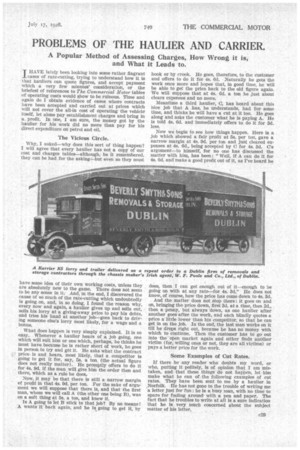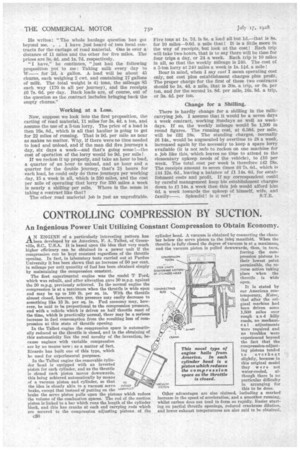PROBLEMS OF THE HAULIER AND CARRIER.
Page 51

Page 52

If you've noticed an error in this article please click here to report it so we can fix it.
A Popular Method of Assessing Charges, How Wrong it is, and What it Leads to.
HAVE lately been looking into some rather flagrant
cases of rate-cutting, trying to understand how it is that hauliers can quote figures, and accept payment which a very few minutes' consideration, or the briefest of references to The Commercial Motor tables of operating costs would show to be ruinous. Time and again do I obtain evidence of cases where contracts have been accepted and carried out at prices which will not cover the all-in cost of operating the vehiclo itself, let alone pay establishment charges and bring in a profit. In one, I am sure, the money got by the haulier for his work did no more than pay for his direct expenditure on petrol and oil.
The Vicious Circle.
Why, I asked—why does this sort of thing happen? I will agree that every haulier has not a copy of our cost and charges tables—although; be it remembered, they can be had for the asking—but even so they must
have some idea of their own working costs, unless they are absolutely new to the game. There does not seem to be any sense in it And, in the end, I discovered the cause of so much of the rate-cutting which undoubtedly is going on, and, in so doing, I found the reason why, every now and again, a haulier gives up and sells out, sells his lorry at a giving-away price to pay his debts, and tries his hand at another job—goes back to driving someone else's lorry most likely, for a wage and a bonus.
What does happen is very simply explained. It is so easy. Whenever a haulier hears of a job going, one which will suit him or one which, perhaps, he thinks he must have because he is rather short of work, he goes in person to try and get it. He asks what the contract price is and hears, most likely, that a competitor is going to get it for, say, 5s. a ton. (the actual figure does not really matter). He promptly offers to do it for 4s. 9d, if the man_ will give him the order then and there, which as a rule he does,
Now, it may be that there is still a narrow margin of profit in that 4s. 9d, per ton. For the sake of argument we will suppose that there is, and that the first man, whom we will call A (the other one being B), was on a soft thing at 5s. a ton, and knew it.
Is A going to let B stick to that job? By no means! A wants it back again, and he is going to get it, by hook or by crook. He goes, therefore, to the customer and offers to do it for 4s. 6d. Naturally he gets the work once more and hopes that, in good time, he will be able to get the price back to the old figure again. We will suppose that at 4s. 6d. a ton he just about clears expenses and no more.
Meantime a third haulier, C, has heard about this nice job that A has, he understands, had for some time, and thinks he will have a cut at it too. He goes along and asks the customer what he is paying A. He is told 4s. 6d. and immediately offers to do it for 3d. less.
Now we begin to see how things happen. Here is a job which showed a fair prat at 5s. per ton, gave a narrow margin at 4s. M. per ton and just cleared expenses at 4s. 6d., being accepted by C for 4s. 3d. C's argument—to himself, for no one has discussed the matter with him, has been : "Well, if A can do it for 4s. 6d. and make a good profit out of it, as I've heard he does, then I can get enough out of it—enough to be going on with at any rate—for 4s. 3d." He does not know, of course, how the price has come down to 4s. 3d.
• And the matter does not stop there: it goes on and on, bringing the price down, first 3d. at a time, then 2d., then a penny, but always down, as one haulier after another goes after the work, and each blindly quotes a price a little lower than his competitor, so that he can get in on the job. In the end, the last man works on it till he drops right out, because he has no money with which to continue. Then the customer has to go out into the open market again and either finds another victim (for, willing ones or not, they are all victims) or pays a better price for the work.
Some Examples of Cut Rates.
If there be any reader who doubts my word, or who, putting it politely, is of opinion that I am mistaken, and that these things do not happen, let him make what he can of the following examples of cut rates. They have been sent to me by a haulier in Norfolk. He has not gone to the trouble of writing me a letter just for fun : he is a busy man, with no time to spare for fooling around. with a pen and paper. The fact that he troubles to write at all is a sure indication that he is very much concerned about the subject matter of his letter.
He writes: "The whole haulage question has got beyond me. . . I have just heard of two local contracts for the cartage of road material. One is over a distance of 11 miles and the other for five miles. The prices are 3s, 4(1. and Is. 7d. respectively.
"I have," he continues, " just had the following proposition put to me : Taking milk every day to W— for 2d. a gallon. A load will be about 45 churns, each weighing 2 cwt. and containing 17 gallons of milk. The total weight is 41 tons, the mileage 85 each way (170 in all per journey), and the receipts £6 7s. 6d per day. Back loads are, of course, out of the question as the contract includes bringing back the empty churns."
Working at a Loss.
Now, suppose we look into the first proposition, the carting of road material, 11 miles for 3s. 4d, a ton, and assume the use of a 5-ton lorry. The price of a. load is then 16s. 8d., which is all that haulier is going to get for 22 miles of running. That is 9d. per mile as near as makes no matter. Why, if there were no time needed to load and unload, and if the man did five journeys a clay, six days a week—and that's going some !—the cost of operation of the lorry would be 9d. per mile!
If we reckon it up properly, and take an hour to load, a quarter of an hour to unload, and an hour and a quarter for the double journey, that's 2 It hours for each load, he could only do three journeys per working day, 15 a week in all, which is 330 miles, and the cost per mile of operating that lorry for 330 miles a week is nearly a shilling per mile. Where is the sense in taking a contract like that?
The other road material job is just as unprofitable.
Five tons at Is. 7d. is Ss. a load all but ld.—that is 8s. for 10 miles-9.6d. p. mile that ! It is a little more in the way of receipts, but look. at the cost 1 Each trip will take two hours, that is to say there will be time for four trips a day, or 24 a week. Each trip is 10 miles in all, so that the weekly mileage is 240. The cost of a 5-ton lorry at 240 miles a week is is. lid, a mile! Bear in mind, when I say cost I mean operating cost only, not cost plus establishment charges plus profit. The proper charge for the first of these two contracts should be is. 4c1. a mile, that is 308. a trip, or 6s. per ton, and for the second is. 8d. per mile, 16s. 8d. a trip, or as. 4d. per ton.
Change for a Shilling.
There is hardly change for a shilling in the milkcarrying job. I assume that it would be a seven days a week contract, working Sundays as well as weekdays. If so, the weekly mileage would be 1,200 in round figures. The running cost, at 6.58d. per mile, will be £32 18s. The standing charges, normally £6 14s., would be augmented by overtime to £8 a week, increased again by the necessity to keep a spare lorry available (it is not safe to reckon on one machine for a job like this,' which leaves no time to attend to the elementary upkeep needs of the vehicle), to £10 per week. The total cost per week is therefore £42 18s. The receipts amount to seven times £6 7s. 6d., which is 144 12s. 6d., leaving a balance of £1 14s. 6d. for establishment costs and profit. If my correspondent could by careful management keep his establishment charges down to £1 14s. a week then this job would afford him 6d. a week towards the upkeep of himself, wife, and family . Splendid ! is it not? .S.T.R. •












































































































